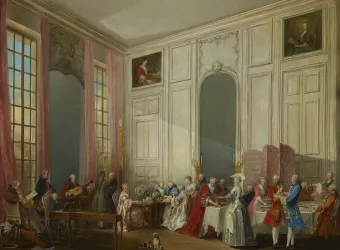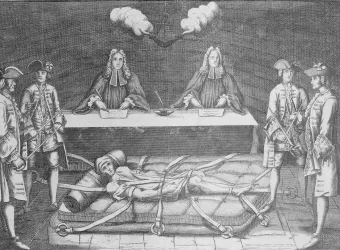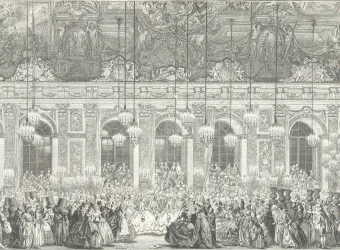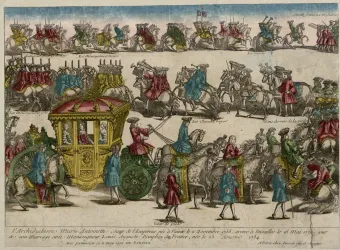Louis XV died, aged 64, on 10 May 1774, in the bedchamber of his Private Apartment. His passing brought to an end a reign of 59 years, the longest in the history of France after that of Louis XIV. Against all expectations, Louis “the Beloved” died an unpopular king.

Death of Louis XV, 1774 10 May 1774
On 26 April the king went to the Petit Trianon with Mme Du Barry and a few members of his close circle. The following day he felt unwell when he woke, suffering aches and pains and a headache, but he nevertheless intended to keep to the planned hunting trip. Still indisposed that evening, he went to bed without eating dinner. Overnight and through the next day his conditioned worsened. On the 28th La Martinière, his First Surgeon, was summoned, and ordered him to be moved to Versailles on the pretext that “Versailles is the place in which to be ill”.
In his bedchamber, lying on a camp bed surrounded by a crowd of doctors and health specialists quarrelling over the diagnosis and treatment to apply, the first blood-letting was carried out on the morning of the 29th. By 10.30 am, however, there was no longer any doubt: the king had smallpox. Never having caught it earlier, he had developed no immunity. To avoid all risk of contagion the Royal family was kept away. Paradoxically, some members of the Court were relieved, since the disease was well-known and they were sure the king would pull through. Others were less sanguine.
ANECDOTE
Amidst cries of “Long live the King!”, the throng of courtiers rushed through the Hall of Mirrors to the Dauphin’s apartment on the ground floor.
The king’s headaches continued, his fever grew hotter, and his body broke out in pustules. By 1 May, though, his condition seemed stable. Gradually, as pus was lanced from his body and face, the king improved. On 8 May the disease reached a decisive stage, at which it could fall off or get worse. But a sharp decline soon set in. The king’s fever resumed, hotter than ever, and his pulse raced; he became delirious and the flow of pus began to dry up. The doctors believed all was lost, and on the 9th his condition continued to decline. The scabs and dry pimples turned black, and the ones on his throat prevented him from swallowing. His Confessor was summoned, as well as his First Almoner, who administered extreme unction. The king, whose face was blackened and distorted by the scabs, was given a final remedy, but with little hope of success. On the morning of 10 May he lay motionless, though still conscious. At 11 am he went into his death throes, and died at 3.15 pm.
Amidst cries of “Long live the King!”, the throng of courtiers rushed through the Hall of Mirrors to the Dauphin’s apartment on the ground floor. According to Mme Campan, Louis XVI and Marie-Antoinette knelt down, embracing each other, and murmured: “My God, guide us and protect us; we are too young to ascend to the throne.”
The reign of Louis XVI had begun. It was to be the last in Versailles.











